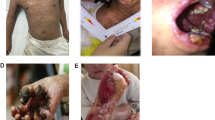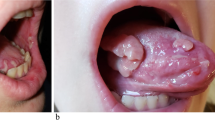Abstract
Castleman disease is a rare lymphoproliferative disorder. The clinical signs and symptoms of the disease are primarily mediated by cytokines, especially interleukin-6. We presented the case of a young female. In May 2004, a 30-year-old otherwise healthy looking woman presented with oral ulcerations resistant to topical and systemic antibiotic and antimycotic treatment. Bullous mucosal lichen or pemphigus vulgaris were suspected. Histological examination and direct and indirect immunofluorescence confirmed the diagnosis of pemphigus. Search for neoplasm revealed a retroperitoneal Castleman tumour sized 15 × 6 × 5 cm in the abdominal MRI. The tumour was a bleeder, so the removal was partial. Histological examination showed hyalin hypervascular Castleman disease. Considering her young, fertile age and the multicentric Castleman disease, non-cytostatic immunomodulatory therapy was started including steroid, cyclosporine-A and thalidomide treatment. The control abdominal CT showed a small residual tumour on the bladder. The residual tumour was removed in repeated surgery. At this time the histological examination showed transient type tumour between plasma cell and vascular variant. Currently, i.e. 4 years after the onset of the disease. 18FDG PET/CT examination showed low metabolic active mass in the right iliacal region, but our patient had no symptoms or complaints. She is on 200 mg thalidomide a day and no tumour progression can be seen. Castleman disease can be successfully treated with non-cytostatic immunomodulatory therapy.








Similar content being viewed by others
References
Castleman B, Thowne VW (1954) Case records of the Massachuetts General Hospital weekly clinicopathological exercises: Case 40011. N Eng J Med 250:26–30
van den Berge M, Pauwels P, Jakimowicz JJ et al (2002) Hyaline vascular Castleman’s disease: a case report and brief review of the literature. Neth J Med 60(11):444–447, Dec
Casper C (2005) The aetiology and management of Castleman disease at 50 years: translating pathophysiology to patient care. Br J Haematol 129:3–17
Oksenhendler E, Carcelain G, Aoki Y et al (2000) High levels of human herpesvirus 8 viral load, human interleukin-6, interleukin-10, and C reactive protein correlate with exacerbation of multicentric Castleman disease in HIV-infected patients. Blood 96:2069–2073
Waterston A, Bower M (2004) Fifty years of multicentric Castleman’s disease. Acta Oncologica 43:698–704
Harris NL, Swerdlow S, Campo E et al (2008) The World Health Organization (WHO) classification of lymphoid neoplasms: what’s new? Ann Oncol 19(4):119
Anhalt GJ, Kim SC, Stanley JR et al (1990) Paraneoplastic pemphigus. An autoimmune mucocutaneus disease associated with neoplasia. N Engl J Med 323:1729–1735
Anhalt GJ (2004) Paraneoplastic pemphigus. J Investig Dermatol Symp Proc 9(1):29–33
Dham A, Peterson BA (2007) Castleman disease. Curr Opin Hematol 14:354–359
Chorzelski T, Hashimoto T, Maciejewska B et al (1999) Paraneoplastic pemphigus associated with Castleman tumor, myasthenia gravis, and bronchiolitis obliterans. J Am Acad Dermatol 41(3):3939–3400
Nishimoto N, Kanakura Y, Aozasa K et al (2005) Humanized anti-interleukin-6 receptor antibody treatment of multicentric Castleman disease. Blood 106:2627–2632
Starkey C, Joste N, Lee FC (2006) Near-total resolution of multicentric Castleman disease by prolonged treatment with thalidomid. Am J Haematol 81:303–304 (letter)
Lee FC, Merchant SH (2003) Alleviation of systemic manifestations of multicentric Castleman’s disease by thalidomide. Am J Hematol 73:48–53
Nikolskaia OV, Nousari CH, Anhalt GJ (2003) Paraneoplastic pemphigus in association with Castleman’s disease. Br J Dermatol 149:1143–1151
Cunha PR, de Oliveira JR, Salles MJ et al (2004) Pemphigus vulgaris with involvement of the cervix treated using thalidomide therapy. Int J Dermatol 43(9):682–684
Hess G, Wagner V, Kreft A et al (2006) Effects of bortezomib on pro-inflammatory cytokine levels and transfusion dependency in a patient with multicentric Castleman disease. Brit J Haematol 134:544–549
Diéval C, Bonnet F, Mauclére S et al (2007) Multicentric Castleman disease: Use of HHV8 viral load monitoring and positron emission tomography during follow-up. Leuk Lymphoma 48(9):1881–1883
Nakamura Y, Tokuyama O, Muso A et al (2002) Asymptomatic pelvic Castleman disease in an infertile woman: case report. Arch Gynecol Obstet 269:156–158
Author information
Authors and Affiliations
Corresponding author
Rights and permissions
About this article
Cite this article
Miltenyi, Z., Toth, J., Gonda, A. et al. Successful Immunomodulatory Therapy in Castleman Disease with Paraneoplastic Pemphigus Vulgaris. Pathol. Oncol. Res. 15, 375–381 (2009). https://doi.org/10.1007/s12253-008-9133-x
Received:
Accepted:
Published:
Issue Date:
DOI: https://doi.org/10.1007/s12253-008-9133-x




